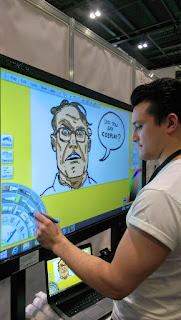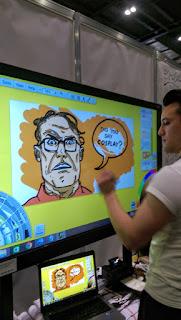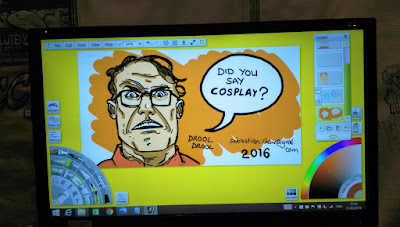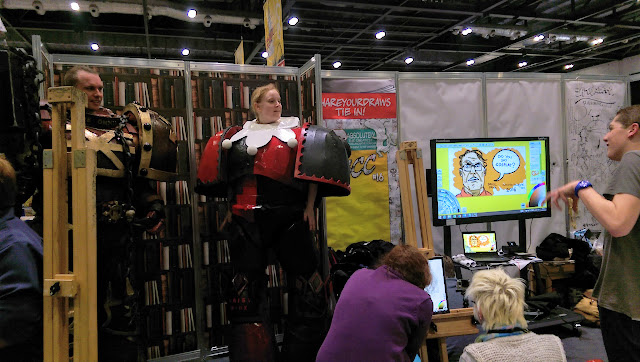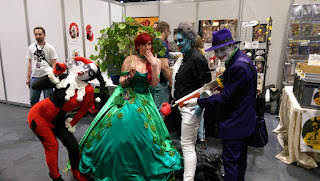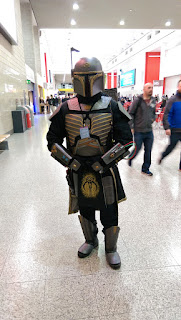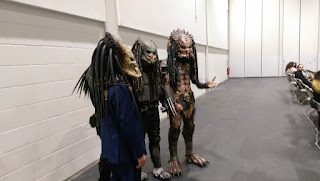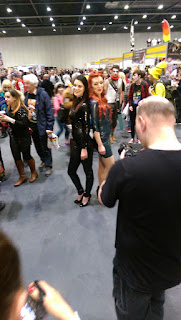Sunday 22 January 2017
2017 Plan
16:54:00
2017 is underway and the clock is ticking. Whats the plan for this year art-wise? Well I have several goals and ideas and the easiest way to talk about it is to break it down into different categories.
Comic cons in the UK have come a long way and whilst they're not as frequent as cons in the US there are now a number of mainstream and independent cons up and down the UK. I've attended London Super Comic Con ever since the first one where Stan Lee attended. This year will be the first year I have booked a table as an exhibitor. That means my very own table in artists alley, selling art and promoting any comics I've made. More on that event in future updates.
I have also applied to Though Bubble 2017 however I am doubtful I will get a place as I think my online presence is weak and currently my comic Catapulted is still WIP. I'm still hopeful and will probably attend even if I don't get a place as an exhibitor.
There are a couple of MCM cons in London however these tend to be super packed and I'm not convinced the artist alley gets much attention as the crowd tends to be a mix of different interests. Also the crowds are large and just attending one day last year felt tiring.
Publish a comic
I have about 20 comic book ideas in storage. These are at various stages but I constantly add to the collection. The idea is that when I finish and complete a project I have at least another idea ready to be developed. Currently I am working on a miniseries Catapulted. See here for the draft cover and for a short description of what the story will be about. Hopefully I can have some prints ready for LSCC2017. I 'm going to try and get it published with a publisher, that process alone will help me see how the publishers see it in terms of quality. Failing that there are many other ways to get published and some of these other methods are ways I want to explore anyway.
Kickstarter
I would like to launch a Kickstarter this year. These can be quite involved but I would like to start small with a modest goal. I see the first Kickstarter as a digital download only comic with various rewards (directors cut, extras etc.) and perhaps a stretch goal for prints or physical rewards.
Webcomic
I did start a Tapastic series last year and had ideas for short 6 panel webcomcis through Tapastic. I would like to continue this, however it won't be a priority. This would be more to take a break from commissions and comic making and draw with no pressure, which seems to help me when I'm try to produce my best art.
Commissions
At the end of last year I tried to advertise commissions a little bit more and to my surprise I got my first commission. Someone had saw the cover to Catapulted and wanted something similar featuring himself in it too. It's currently WIP but commissions are something I'll be doing more of, especially as I prepare to exhibit at my first con.
And that's it for now. Quite a lot to achieve but without goals and plans its unlikely that you will achieve a lot. Subscribe to my newsletter if you want updates in your inbox, use the form on the main page of the blog on the right hand side.
Newsletter!
16:46:00
So I thought I would start a newsletter to help build my subscriber base to my blog. Whilst some social platforms are great for promoting art/comics, newsletter subscriptions are the best and most consistent way to reach people who want to keep up to date with your content creation.
Therefore I launched my first newsletter last week. To the starters who did subscribe, thank you and I look forward to sending updates on my content as well as useful articles on different aspects of comic book creation.
What kind of articles could you expect if you did subscribe? Here are a few topics:
- Updates on new articles discussing writing, penciling, inking, coloring and lettering comics
- Updates on conventions as well as my first experiences exhibiting at Comic Con
- Reviews of useful books and tools for making comics
- Updates on my creator owned comic Catapulted
- Reviews of online comic book platforms (Tapastic, Comixology, Webtoons etc.)
I kept my first newsletter light and I did mention that its not going to be a super frequent newsletter that is super long. Instead it's going to be succinct and to the point as often I find newsletters I've subscribed to lengthy and sometimes a bit spammy.
However I did receive a response from one of my subscribers suggesting a schedule so at least the newsletters are regular and can be expected. The opposite end of the spectrum is that newsletters aren't frequent enough which therefore runs the risk of getting forgotten, meaning your content never gets looked at.
Therefore I've decided to send a newsletter twice a month. Content wise I think that's all I could handle at the moment.
How do you subscribe to the newsletter?
At the top of my blog on the right is a small sign up form, pop your email in and away you go, or more so your email address.
Monday 12 December 2016
The Three Plots?
15:44:00
I once read that every story that can be told has
been told already. Many stories are reconfigured, disguised in
such a way that the audience is feels like they're seeing something
new and different. I didn't want to believe it but the more I boiled down and reduced stories to their bare plot elements, the more this seemed so. So, what are those three plots?
- The Mysterious Stranger
- The Quest
- The Genesis Story
That's it. Hard to believe isn't it? When you boil the story down, you will come to one or more of these three basic
plots. Yes, this is reducing stories to the extreme, but these are not where you
end. It's where you begin. Let's consider them one at a time.
Someone or something enters a community. The story built around
this plot often follows one (or both) of these two questions:
- What is this stranger's impact on the community?
- What is the community's impact on the stranger?
If it does not follow either of those questions, then the stranger may be used as a lens by which the author reveals the characters and/or community in which the stranger finds him or herself.
THE QUEST
This can be a
search for anything: love, treasure, the identity of the Mysterious
Stranger. All mysteries are built around the quest for the solution. You might
consider some subcategories to the Quest. It could be said that the quest is too broad and you could break things down further,
including such categories as the Chase and the Hunt. While these are all valid, they can still be seen as all being quests of one
sort or another.
THE GENESIS STORY
How something or someone came to be. In comic book terms, this is
the origin story.
When I thought about my favorite stories and I started to see at the heart of them is one or more of these
three basic plots. It is an art, to find new stories to tell based on these plots. This is where artistic vision
comes into play. We are all individuals, shaped by our experiences. It is our
unique perspective on these three stories that will give our work a distinctive
voice.
Remember if you are a duck there are special offers at Heinemann apparently...
Remember if you are a duck there are special offers at Heinemann apparently...
Wednesday 30 November 2016
Comics: Art in Relationship
16:19:00
If you like Scott McCloud's books on analyzing the comic book form or you enjoy Will Eisner's comments on comics and the form of sequential art then you will enjoy the free course Comics: Art in Relationship.
This course analyzes the question 'What are comics?' and the course instructor, Matt Silady, does an excellent job in providing an answer that can be tested with examples. There are 5 sessions but within each session there are multiple lessons. These include image and text relationships, thumbnailing, layouts and pacing.
The course material could be covered in a day however if you were to partake in the exercises it would most likely take longer. If you are familiar with the process of making comics and want something a little deeper on this interesting and challenging medium then this is a great course.
What makes it even better?
It's free. Completely and absolutely free. Register an account and sign up and the content is there for you to enjoy. You can even participate in the forums for feedback. This was a real gem to find and I thoroughly enjoyed the material. You can access the content any time you want and take it at your own pace. I believe the course ends in Jan 2017 sometime but that's plenty of time to make use of the course material.
By the end of the course you should be equipped to start planning and making a comic of your own.
Below is a link to the course. Enjoy!
https://www.kadenze.com/courses/comics-art-in-relationship-ii
This course analyzes the question 'What are comics?' and the course instructor, Matt Silady, does an excellent job in providing an answer that can be tested with examples. There are 5 sessions but within each session there are multiple lessons. These include image and text relationships, thumbnailing, layouts and pacing.
What makes it even better?
It's free. Completely and absolutely free. Register an account and sign up and the content is there for you to enjoy. You can even participate in the forums for feedback. This was a real gem to find and I thoroughly enjoyed the material. You can access the content any time you want and take it at your own pace. I believe the course ends in Jan 2017 sometime but that's plenty of time to make use of the course material.
By the end of the course you should be equipped to start planning and making a comic of your own.
Below is a link to the course. Enjoy!
https://www.kadenze.com/courses/comics-art-in-relationship-ii
Friday 18 November 2016
Triangles?
18:53:00
Trying to create a my own comic book is not easy when you are a one man band. In most cases creative teams consist of a writer, penciler, inker, colorist, letterer and maybe an editor. There are times when a creator is able to fulfill more than one of these roles and in rare cases all of the roles. However this means a lot of cross training in all these steps of comic book creation.
In my own case I started out as an pencil artist (not a great one at that) and tried learning how to ink, then letter, coloring and lastly writing. Learning to write a comic book has probably been the hardest. With the other steps there are scores of YouTube videos, on line How-To articles and books on how to put the visual aspects of comics together. However, writing comics isn't that easy, at least for me.
So, where do we start? How do you go from an idea to a piece of work that makes sense as a story?
A long time ago I read an online article that articulated how to make sense of an idea and progress it to a finished comic book. Unfortunately I can't remember the site and author although I would love to credit where I found this information.
I'll break the writing process into separate posts. But first lets talk about triangles.
Triangles... Doritos? Cheese triangles? Flying space triangles? No. The story triangle.
You will find that there are four basic elements in constructing a story as illustrated by the diagram below.
In my own case I started out as an pencil artist (not a great one at that) and tried learning how to ink, then letter, coloring and lastly writing. Learning to write a comic book has probably been the hardest. With the other steps there are scores of YouTube videos, on line How-To articles and books on how to put the visual aspects of comics together. However, writing comics isn't that easy, at least for me.
So, where do we start? How do you go from an idea to a piece of work that makes sense as a story?
A long time ago I read an online article that articulated how to make sense of an idea and progress it to a finished comic book. Unfortunately I can't remember the site and author although I would love to credit where I found this information.
I'll break the writing process into separate posts. But first lets talk about triangles.
Triangles... Doritos? Cheese triangles? Flying space triangles? No. The story triangle.
You will find that there are four basic elements in constructing a story as illustrated by the diagram below.
The Characters
This is the "who". Who are the main characters? Who are the supporting characters? Are some heroes or villains? What are their motivations and characteristics? Do they have personality flaws? Are they following a certain stereotype? What do they look like? How do they dress?
Lots of questions when it comes to characters but this is basically the "who".
This is the "who". Who are the main characters? Who are the supporting characters? Are some heroes or villains? What are their motivations and characteristics? Do they have personality flaws? Are they following a certain stereotype? What do they look like? How do they dress?
Lots of questions when it comes to characters but this is basically the "who".
The Plot
This is the "what". What do your characters want and what happens? It is the simple sequence of events. For example:
Rosie wants to be on time for work. Unfortunately, she wakes up late. Natalie makes her breakfast. Rosie eats breakfast quickly, dripping egg yolk on her shirt. Now Rosie has to change her clothes, making her even later for work. Rosie leaves the house in a rush, not looking in both directions before she crosses the street. Rosie is hit by a bus and dies. That is a plot.
That's what happens. The plot is the series of conflicts and resolutions leading to the climax and ending where everything is tied together.
This is the "what". What do your characters want and what happens? It is the simple sequence of events. For example:
Rosie wants to be on time for work. Unfortunately, she wakes up late. Natalie makes her breakfast. Rosie eats breakfast quickly, dripping egg yolk on her shirt. Now Rosie has to change her clothes, making her even later for work. Rosie leaves the house in a rush, not looking in both directions before she crosses the street. Rosie is hit by a bus and dies. That is a plot.
That's what happens. The plot is the series of conflicts and resolutions leading to the climax and ending where everything is tied together.
The Story
This is the where, when, how, and why. Where and when are surface details, but they are important as they determine how the character and society act and react. People in feudal Japan would not act in the same way that Native Americans would act in 1800America
The plot described above with Rosie would have to happen in fairly large, modern city where cars and buses exist. It could not be transplanted toFrance
This is the where, when, how, and why. Where and when are surface details, but they are important as they determine how the character and society act and react. People in feudal Japan would not act in the same way that Native Americans would act in 1800
The plot described above with Rosie would have to happen in fairly large, modern city where cars and buses exist. It could not be transplanted to
How expands on
the question of "What do you characters want?" by exploring how they
go about achieving their goals. We then ask the question of why should the
events of the plot matter to the characters and the readers.
Ultimately, the
story is the impact of Rosie's death on Natalie, the bus driver, other characters,
and most importantly, on the reader. Why should the reader care about Jimmy's
death and its ramifications? Therein lies the story.
The Theme or
Premise
Every story sets out to prove its theme or premise. In the story outlined above, the premise might be "Remember to set your alarm clock so you don't wake up late." The consequences of not setting your alarm clock are then spelled out. The theme or premise does not have to be overly complex. It can be as simple as "Love conquers all" or "Crime doesn't pay" or "With great power comes great responsibility" (sound familiar?).
It can be much more complex, perhaps trying to prove or disprove the existence of a higher power. It doesn't matter how simple or complex your premise, as long as everything in the context of the tale--the characters, the plot, and the story--all relate to the theme in some way, shape, or form to your theme. Ultimately, when someone asks what the story is about, they will usually zero in on the theme or premise.
Every story sets out to prove its theme or premise. In the story outlined above, the premise might be "Remember to set your alarm clock so you don't wake up late." The consequences of not setting your alarm clock are then spelled out. The theme or premise does not have to be overly complex. It can be as simple as "Love conquers all" or "Crime doesn't pay" or "With great power comes great responsibility" (sound familiar?).
It can be much more complex, perhaps trying to prove or disprove the existence of a higher power. It doesn't matter how simple or complex your premise, as long as everything in the context of the tale--the characters, the plot, and the story--all relate to the theme in some way, shape, or form to your theme. Ultimately, when someone asks what the story is about, they will usually zero in on the theme or premise.
Friday 11 November 2016
Comic Cons 2016
21:34:00
Recently I went to two comic cons that I don't usually go to. MCM ComicCon and ThoughtBubble.
How did it go?
MCM Comic Con
I've always known that MCM has drawn large crowds historically but I wasn't prepared for how packed it would be. I only went to the Sunday but friends who attended all three days had told me that the Saturday had sold out and that it was almost impossible to walk around with the crowds.
 MCM in London is typically held in the Excel Centre. But whereas London Super ComicCon (held in the same venue) takes up 3 or 4 halls, MCM took up practically all the halls, both sides!
MCM in London is typically held in the Excel Centre. But whereas London Super ComicCon (held in the same venue) takes up 3 or 4 halls, MCM took up practically all the halls, both sides!
Of course MCM is not just about comics or manga, it has merchandise stalls, film, game, food and even karaoke areas! Halls on both sides of the main corridor were used, all filled with cosplayers who had traveled from all over Europe.
Although enjoyable with lots to see and do, I prefer cons that are solely focused on comics.
ThoughtBubble 2016
Now here is an interesting convention. ThoughtBubble has always been held in the city of Leeds, something that had always put me off from attending as its a good 4 hour car journey from London.
However I did not realize that some amazing writers and artists have been attending for years! In times past Adam Hughes has attended (an artist I've always wanted to meet and chat to).
This year saw Mike Mignola, Neil Gaiman and Kim Jung Ji as well as many others attend. The event is spread around the Royal Armories Museum. The benefit of this venue is that panels can be held in nice theater auditoriums where panelists can be heard clearly (unlike at the Excel Center). I attended one panel on how to make money from comics where the panelists shared their own experience which was very helpful.
Watching Kim Jung Gi was a treat, transforming a huge blank canvas into a an amazingly detailed picture before a crowd of onlookers. How he manages to do these pictures, without reference and planning will always amaze me.
I got to buy some sketch books and a piece of original art from artists in artist alley, include Dean Beattie, Dave Stokes and also got to speak to some creators including Chris Lewis who I met at Kapow Comic Con years ago when he first self published Drones before IDW picked it up.
I had entered the yearly art competition, from which the top three entries get published in a ThoughtBubble anthology published by Image comics. Unfortunately I didn't come in the top three but it was a good experience to complete a one page comic within a finite period, something I often struggle with.
On the bright side I put the comic into a format that would be suitable to Tapastic and I think it will be an ongoing series of short 'slice-of-life' strips.
Check it out in the link below! Tapastic also has an Android and IOS app for you to enjoy comics. Search for 'Sebastian Chow' or 'Art Imitates Life' and subscribe and like the comic. Alternatively you can view it on their site without an account by clicking the link.
https://tapastic.com/series/Art-Imit
Leeds was also a lovely city to visit and in the main shopping center there was a replica of the 1989 Batman Batmobile (my favorite look of all the films). Needless to say I took some snaps.
I would love to go back to ThoughtBubble and even hire a table for commissions and selling art however I know this can be difficult with many being turned away due to the high volume of requests and limited space.
Onward to LSCC 2016 which now has a new venue and new dates...
How did it go?
MCM Comic Con
I've always known that MCM has drawn large crowds historically but I wasn't prepared for how packed it would be. I only went to the Sunday but friends who attended all three days had told me that the Saturday had sold out and that it was almost impossible to walk around with the crowds.
 MCM in London is typically held in the Excel Centre. But whereas London Super ComicCon (held in the same venue) takes up 3 or 4 halls, MCM took up practically all the halls, both sides!
MCM in London is typically held in the Excel Centre. But whereas London Super ComicCon (held in the same venue) takes up 3 or 4 halls, MCM took up practically all the halls, both sides!Of course MCM is not just about comics or manga, it has merchandise stalls, film, game, food and even karaoke areas! Halls on both sides of the main corridor were used, all filled with cosplayers who had traveled from all over Europe.
Although enjoyable with lots to see and do, I prefer cons that are solely focused on comics.
ThoughtBubble 2016
Now here is an interesting convention. ThoughtBubble has always been held in the city of Leeds, something that had always put me off from attending as its a good 4 hour car journey from London.
However I did not realize that some amazing writers and artists have been attending for years! In times past Adam Hughes has attended (an artist I've always wanted to meet and chat to).
This year saw Mike Mignola, Neil Gaiman and Kim Jung Ji as well as many others attend. The event is spread around the Royal Armories Museum. The benefit of this venue is that panels can be held in nice theater auditoriums where panelists can be heard clearly (unlike at the Excel Center). I attended one panel on how to make money from comics where the panelists shared their own experience which was very helpful.
Watching Kim Jung Gi was a treat, transforming a huge blank canvas into a an amazingly detailed picture before a crowd of onlookers. How he manages to do these pictures, without reference and planning will always amaze me.
I got to buy some sketch books and a piece of original art from artists in artist alley, include Dean Beattie, Dave Stokes and also got to speak to some creators including Chris Lewis who I met at Kapow Comic Con years ago when he first self published Drones before IDW picked it up.
I had entered the yearly art competition, from which the top three entries get published in a ThoughtBubble anthology published by Image comics. Unfortunately I didn't come in the top three but it was a good experience to complete a one page comic within a finite period, something I often struggle with.
On the bright side I put the comic into a format that would be suitable to Tapastic and I think it will be an ongoing series of short 'slice-of-life' strips.
Check it out in the link below! Tapastic also has an Android and IOS app for you to enjoy comics. Search for 'Sebastian Chow' or 'Art Imitates Life' and subscribe and like the comic. Alternatively you can view it on their site without an account by clicking the link.
https://tapastic.com/series/Art-Imit
Leeds was also a lovely city to visit and in the main shopping center there was a replica of the 1989 Batman Batmobile (my favorite look of all the films). Needless to say I took some snaps.
I would love to go back to ThoughtBubble and even hire a table for commissions and selling art however I know this can be difficult with many being turned away due to the high volume of requests and limited space.
Onward to LSCC 2016 which now has a new venue and new dates...
MCM Comic Con
ThoughtBubble/Leeds
Tuesday 12 July 2016
Great Advice
17:31:00
Speaking to creators at comic conventions can yield a wealth of advice and help. Sebastian Antoniou who is an artist that gave some great feedback when comparing some of my finished pages and sketches in my sketch book.
The problem I was having was that art in my sketch book was fluid, dynamic and pleasant to the eye (at least my eye). However when I worked on finished sequential pages, the art was stiff and less dynamic. Also the style of the art seemed to change drastically.
Here's an example from and old sketch and an old "finished" page. These are meant to be the same character, sketchbook version on the left and the Bristol board (scanned and grey-scaled) version on the right.
I think there are several reasons why this is the case:
However even when things were penciled out nicely, another factor to stiff pages seemed to be my inking process. I was using the famed Hunt 102 nib that so many inkers used. The problem? It takes lots of practice and skill to ink with this tool.
The advice from Seb Antoniou? He asked me what tools I used when inking sketches in my sketch book. I said I used fine-liners. He then asked why I was then switching to a completely different tool when in most cases I want to capture the art in my sketch books (just in a neater presentation).
I thought about it and it was true. I didn't need to be true to a particular method that wasn't my method... yet.
So Catapulted will be inked mainly with fine-liners as that's what I'm used to and hopefully it's going to get me the results I want in my pages.
Long story short? Don't sacrifice the art by sticking rigidly to a method that isn't yet yours and get feedback on your work from other creators (even if it's a 5 min chat).
The problem I was having was that art in my sketch book was fluid, dynamic and pleasant to the eye (at least my eye). However when I worked on finished sequential pages, the art was stiff and less dynamic. Also the style of the art seemed to change drastically.
Here's an example from and old sketch and an old "finished" page. These are meant to be the same character, sketchbook version on the left and the Bristol board (scanned and grey-scaled) version on the right.
I think there are several reasons why this is the case:
- I seem to have a mental block between drawing on a cheap sketchbook (on which I can discard the page) and drawing on a nice new, pristine piece of Bristol board
- Not planning the thumbnails out properly
- Not sketching or planning out the page layout and rough pencils in a clear enough fashion before inking
However even when things were penciled out nicely, another factor to stiff pages seemed to be my inking process. I was using the famed Hunt 102 nib that so many inkers used. The problem? It takes lots of practice and skill to ink with this tool.
The advice from Seb Antoniou? He asked me what tools I used when inking sketches in my sketch book. I said I used fine-liners. He then asked why I was then switching to a completely different tool when in most cases I want to capture the art in my sketch books (just in a neater presentation).
I thought about it and it was true. I didn't need to be true to a particular method that wasn't my method... yet.
So Catapulted will be inked mainly with fine-liners as that's what I'm used to and hopefully it's going to get me the results I want in my pages.
Long story short? Don't sacrifice the art by sticking rigidly to a method that isn't yet yours and get feedback on your work from other creators (even if it's a 5 min chat).
Sunday 13 March 2016
CATAPULTED - LOGO!
18:09:00
Slow progress is still progress... I think. This blog is described as "a quest to create an original creator owned, graphic novel". That novel is going to be CATAPULTED.
Previously I had started a different story called CLANDESTINE but apart from an interesting premise, I wasn't too confident on the story. I also recently discovered a similarly titled comic called CLANDESTINO, published by Black Mask Studios (the stories were in no way similar).
After successfully illustrating an anthology and attending LSCC 2016 and getting some great advice from artists/creators in the industry, I resumed efforts to complete my own story.
I'm a big fan of Will Eisner's "Comics and Sequential art" and all of Scott McCloud's books which really raise the value of comics as a medium for storytelling (highlighting the advantages over other mediums). Both creators also emphasize the strength in single creator storytelling over a team of creators. Sometimes the single clear vision of a single storyteller can be more effective than a team even if certain elements like the art are better.
Reviewing these books really helps find a starting place for what is required for most comic submissions... the 5 page preview.
Most publishers require a synopsis and a 5 page preview to see what the finished comic will look like if it was to be printed. A 5 page preview also reveals other key information:
All of this helps a publisher decide on whether a book is worth taking on. And with the amount of submissions publishers receive, 5 pages is more than enough.
Thus some of the future posts will be more centered on the different features connected with getting those 5 pages completed, character sketches, page layouts, covers and.... logos!
With that preamble I present the current logo (which may be subject change):
Part of the design was inspired by the rocket tips that housed the poor cat that was to be sent into space seen below.
Previously I had started a different story called CLANDESTINE but apart from an interesting premise, I wasn't too confident on the story. I also recently discovered a similarly titled comic called CLANDESTINO, published by Black Mask Studios (the stories were in no way similar).
After successfully illustrating an anthology and attending LSCC 2016 and getting some great advice from artists/creators in the industry, I resumed efforts to complete my own story.
I'm a big fan of Will Eisner's "Comics and Sequential art" and all of Scott McCloud's books which really raise the value of comics as a medium for storytelling (highlighting the advantages over other mediums). Both creators also emphasize the strength in single creator storytelling over a team of creators. Sometimes the single clear vision of a single storyteller can be more effective than a team even if certain elements like the art are better.
Reviewing these books really helps find a starting place for what is required for most comic submissions... the 5 page preview.
Most publishers require a synopsis and a 5 page preview to see what the finished comic will look like if it was to be printed. A 5 page preview also reveals other key information:
- Is the storytelling clear?
- Will the reader be interested in turning the page by page 5 or will they be bored?
- Is this a black and white or colour comic (has an impact on cost)?
All of this helps a publisher decide on whether a book is worth taking on. And with the amount of submissions publishers receive, 5 pages is more than enough.
Thus some of the future posts will be more centered on the different features connected with getting those 5 pages completed, character sketches, page layouts, covers and.... logos!
With that preamble I present the current logo (which may be subject change):
The logo feels a little bit too "clean" and "vectorish" (if that makes any sense). But a logo is a start and once it is on a cover it might become more apparent what needs tweaking.
Part of the design was inspired by the rocket tips that housed the poor cat that was to be sent into space seen below.
More on the history of cats in space later...
Friday 26 February 2016
LSCC 2016 - Paul Kercal
20:27:00
The first of many videos from Paul Kercal who ran the art stand at LSCC 2016 this year.
Thanks for the cool footage and the mention.
Thanks for the cool footage and the mention.
Thursday 25 February 2016
LSCC 2016 ArtRage/Surface Pro Mash up
16:00:00
There were many stands at London Super Comic Con 2016 this year but one stand I spent quite a bit of time at was the very welcoming art stand run by Paul Kercal and some of his student helpers.
From what I can tell there are various bits of tech and software coming together to help form this stand:
From what I can tell there are various bits of tech and software coming together to help form this stand:
- Promethean hardware: Imagine a flat screen TV that acts as a giant touchscreen monitor, has multi-touch functionality and a whiteboard style marker as a drawing stylus. This was running windows and Art Rage software. This was great fun to use and reminds me of use a big whiteboard with markers (incidentally my current work place has whiteboard paint on the walls which is great for doodling while making coffee in the kitchen). I used this screen twice doing a couple of sketches, one I even managed to colour.
- Surface Pro Tablets: Not sure if these were Surface Pro 3's or 4's but they had several Pros set up on easels running either Art Rage or Micrsoft Fresh Paint. I had never used Fresh Paint before and although it does not have layer support like Art Rage it did have great emulation of brushes/pens and canvas types. A couple of cosplayers in very tall and impressively made suits posed for some sketches.
I also won a small sketch competition and won a figurine statue of a new character that Markosia is publishing. Hope I can find some of the snaps taken when they get tweeted out or reported on.
I'll update this post with the pics when I they are released.
It was a great stand and I love the idea of getting non exhibitors to create art or comic art on great technology and software.
Tuesday 23 February 2016
LSCC 2016!
20:54:00
London Super Comic Con 2016 whizzed its way around the calendar and housed itself in back in the Excel where, incidentally, there was a baby exhibition, a classic car exhibition and a franchise exhibition on at the same time. So making my way between heavily pregnant women, businessmen and car enthusiasts I hurried my way through the crowd to make it to LSCC.
LSCC has definitely improved over the years. Each year seems to see an increase in attendees. Not even the gloomy weather and slight rain could dampen the spirit of cosplayers and comic book fans. I think there were more cosplayers this year than ever, and LSCC was prepared with several panel events and stands dedicated to cosplaying.
However I was there for different reasons. I attended panels on publishing your own comic, sequential storytelling and inking (discussed by Scott Williams). All three of these were enjoyable but I particularly enjoyed the inking panel with Mr. Williams who related his experiences of working with other creators like Jim Lee.
I met various comic creators and Comic Con is always a great place to get feedback, advice as well as network with other creators for future projects. In addition, there was an impressive list of artists and writers from all over the globe including all round nice guy, David Finch, who I interviewed back in LSCC 2013 (as a very obvious novice to doing interviews).
I bought some comics, some art supplies and even spent some time at a very interesting and fun stand (more to come on that). I will make blog posts on each of these aspects in a bit more detail but for now enjoy a few snaps taken throughout the con.
LSCC has definitely improved over the years. Each year seems to see an increase in attendees. Not even the gloomy weather and slight rain could dampen the spirit of cosplayers and comic book fans. I think there were more cosplayers this year than ever, and LSCC was prepared with several panel events and stands dedicated to cosplaying.
However I was there for different reasons. I attended panels on publishing your own comic, sequential storytelling and inking (discussed by Scott Williams). All three of these were enjoyable but I particularly enjoyed the inking panel with Mr. Williams who related his experiences of working with other creators like Jim Lee.
I met various comic creators and Comic Con is always a great place to get feedback, advice as well as network with other creators for future projects. In addition, there was an impressive list of artists and writers from all over the globe including all round nice guy, David Finch, who I interviewed back in LSCC 2013 (as a very obvious novice to doing interviews).
I bought some comics, some art supplies and even spent some time at a very interesting and fun stand (more to come on that). I will make blog posts on each of these aspects in a bit more detail but for now enjoy a few snaps taken throughout the con.
Subscribe to:
Posts (Atom)
































